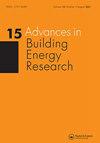Digital Twin of HVAC system (HVACDT) for multiobjective optimization of energy consumption and thermal comfort based on BIM framework with ANN-MOGA
IF 2.5
Q2 CONSTRUCTION & BUILDING TECHNOLOGY
引用次数: 8
Abstract
ABSTRACT This study proposes a novel Digital Twin framework of heating, ventilation, and air conditioning (HVACDT) system to reduce energy consumption while increasing thermal comfort. The framework is developed to help the facility managers better understand the building operation to enhance the HVAC system function. The Digital Twin framework is based on Building Information Modelling (BIM) combined with a newly created plug-in to receive real-time sensor data as well as thermal comfort and optimization process through Matlab programming. In order to determine if the suggested framework is practical, data were collected from a Norwegian office building between August 2019 and October 2021 and used to test the framework. An artificial neural network (ANN) in a Simulink model and a multiobjective genetic algorithm (MOGA) are then used to improve the HVAC system. The HVAC system is comprised of air distributors, cooling units, heating units, pressure regulators, valves, air gates, and fans, among other components. In this context, several characteristics, such as temperatures, pressure, airflow, cooling and heating operation control, and other factors are considered as decision variables. In order to determine objective functions, the predicted percentage of dissatisfied (PPD) and the HVAC energy usage are both calculated. As a result, ANN's decision variables and objective function correlated well. Furthermore, MOGA presents different design factors that can be used to obtain the best possible solution in terms of thermal comfort and energy usage. The results show that the average cooling energy savings for four days in summer is roughly 13.2%, and 10.8% for the three summer months (June, July, and August), keeping the PPD under 10%. Finally, compared to traditional approaches, the HVACDT framework displays a higher level of automation in terms of data management.基于BIM框架和ANN-MOGA的暖通空调系统能耗和热舒适多目标优化数字孪生(HVACDT
摘要:本研究提出了一种新的暖通空调(HVACDT)系统的数字孪生框架,以减少能源消耗,同时提高热舒适。开发该框架是为了帮助设施管理人员更好地了解建筑物的运行情况,以增强暖通空调系统的功能。Digital Twin框架基于建筑信息模型(BIM),结合新创建的插件,通过Matlab编程接收实时传感器数据以及热舒适和优化过程。为了确定建议的框架是否可行,研究人员在2019年8月至2021年10月期间从挪威办公楼收集了数据,并用于测试该框架。然后采用Simulink模型中的人工神经网络(ANN)和多目标遗传算法(MOGA)对暖通空调系统进行改进。暖通空调系统由空气分配器、冷却装置、加热装置、压力调节器、阀门、风门和风扇等部件组成。在这种情况下,几个特性,如温度,压力,气流,冷却和加热操作控制,以及其他因素被认为是决策变量。为了确定目标函数,计算了预测不满意率(PPD)和暖通空调能耗。结果表明,人工神经网络的决策变量与目标函数具有良好的相关性。此外,MOGA提出了不同的设计因素,可以用来获得热舒适和能源使用方面的最佳解决方案。结果表明,夏季4天的平均制冷节能约为13.2%,夏季6、7、8三个月的平均制冷节能约为10.8%,使PPD低于10%。最后,与传统方法相比,HVACDT框架在数据管理方面显示出更高的自动化水平。
本文章由计算机程序翻译,如有差异,请以英文原文为准。
求助全文
约1分钟内获得全文
求助全文
来源期刊

Advances in Building Energy Research
CONSTRUCTION & BUILDING TECHNOLOGY-
CiteScore
4.80
自引率
5.00%
发文量
11
 求助内容:
求助内容: 应助结果提醒方式:
应助结果提醒方式:


